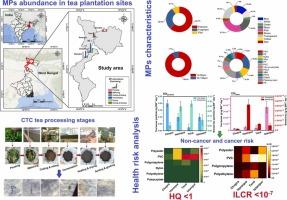CTC茶中微塑料污染源溯源:加工阶段影响及人体健康风险评估
IF 11.3
1区 环境科学与生态学
Q1 ENGINEERING, ENVIRONMENTAL
引用次数: 0
摘要
在全球范围内,茶是一种广泛消费的饮料,据报道,茶被微塑料污染,尤其是在茶包中。然而,缺乏CTC(“压碎、撕裂、卷曲”)茶的可能来源预约数据。本研究考察了CTC制茶过程中不同阶段MPs的丰度。MPs (10-82.4 μm)污染在发酵阶段最高(1.1个颗粒g-1),在干燥阶段最低(0.4个颗粒g-1),以聚乙烯、聚丙烯酸酯、聚氯乙烯和尼龙为主。采摘、切割和滚动阶段与纤维和碎片MPs的丰度较高有关。此外,塑料制成的茶叶加工设备,如萎凋槽、输送带、纤维提取机等,也是造成CTC茶中MPs污染的原因。CTC茶和冲泡茶的EDIparticles分别为0.03 ~ 0.2和0.05 ~ 0.28 particles kg BW-1 day-1。估计MPs的平均摄入率(ARMI)为6.19-73.9 μg /人-1年。非癌(HQ)和癌风险(ILCR)指数分别为1.53×10-8 ~ 5.44×10-5和1.45×10-9 ~ 2.59×10-7,均在安全范围内。该研究为CTC茶加工阶段的MPs污染以及与之相关的健康风险提供了基线数据。本文章由计算机程序翻译,如有差异,请以英文原文为准。

Tracing source of microplastics contamination in CTC tea: Effect of processing stages and human health risk assessment
Globally, tea is a widely consumed beverage and is reported to be contaminated with microplastics (MPs), especially in tea bags. However, data is lacking in CTC (‘crush, tear, curl’) tea with a possible source appointment. Present study investigated abundance of MPs at different stages of CTC tea manufacturing process. MPs (10–82.4 μm) contamination was found highest at fermentation stage (1.1 particles g−1) and lowest at drying stage (0.4 particles g−1), with prevalence of polyethylene, polyacrylates, polyvinyl chloride, and nylon. Plucking, cutting & rolling stages were associated with a higher abundance of fibrous and fragmented MPs. Further, tea processing equipment made of plastics, viz., withering trough, conveyor belt, fiber extractor machine, etc., contributes to MPs contamination in CTC tea. EDIparticles for CTC tea and brewed tea were 0.03–0.2 and 0.05–0.28 particles kg BW−1 day−1, respectively. Estimated average rate of MPs ingested (ARMI) was 6.19–73.9 μg person−1 year−1. Non-cancer (HQ) and cancer risk (ILCR) indices ranged from 1.53 × 10−8 to 5.44 × 10−5 and 1.45 × 10−9 to 2.59 × 10−7, respectively, which are within safety limits. The study generates baseline data for MPs contamination in processing stages of CTC tea and health risk associated with it.
求助全文
通过发布文献求助,成功后即可免费获取论文全文。
去求助
来源期刊

Journal of Hazardous Materials
工程技术-工程:环境
CiteScore
25.40
自引率
5.90%
发文量
3059
审稿时长
58 days
期刊介绍:
The Journal of Hazardous Materials serves as a global platform for promoting cutting-edge research in the field of Environmental Science and Engineering. Our publication features a wide range of articles, including full-length research papers, review articles, and perspectives, with the aim of enhancing our understanding of the dangers and risks associated with various materials concerning public health and the environment. It is important to note that the term "environmental contaminants" refers specifically to substances that pose hazardous effects through contamination, while excluding those that do not have such impacts on the environment or human health. Moreover, we emphasize the distinction between wastes and hazardous materials in order to provide further clarity on the scope of the journal. We have a keen interest in exploring specific compounds and microbial agents that have adverse effects on the environment.
 求助内容:
求助内容: 应助结果提醒方式:
应助结果提醒方式:


